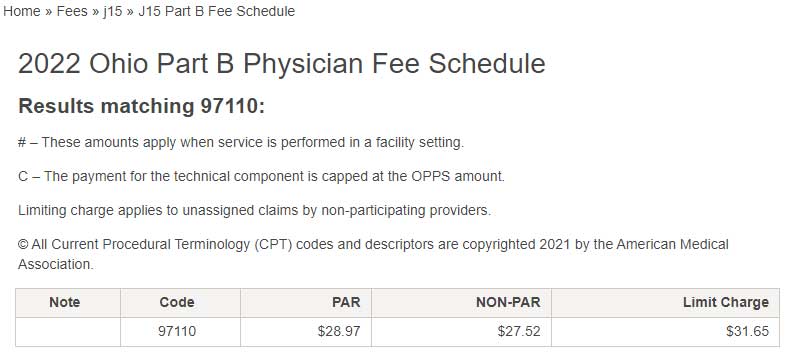CPT Code Therex 97110
CPT Code Therex 97110 (Therapeutic Exercise) was the 4th highest ranked procedure code listed on the 2021 CMS CERT Overpayment Top 20 List.
What is the Medicare definition of CPT Code Therex 97110?
Reference: LCD L34049
“Therapeutic exercises are used for the purpose of restoring or maintaining strength, endurance, range of motion and flexibility where loss or restriction is a result of a specific disease or injury and has resulted in a functional limitation. Therapeutic exercises may require active, active-assisted, or passive participation by the patient (e.g., isokinetic exercise, lumbar stabilization, stretching and strengthening).”
Documentation to Support the Use of CPT Code Therex 97110
“Documentation should include not only measurable indicators such as functional loss of joint motion or muscle strength, but also information on the impact of these limitations on the patient’s life and how improvement or maintenance in one or more of these measures effects patient function.”
“Documentation of progress should show the condition is responsive to the therapy chosen and that the response is (or is expected to be) clinically meaningful. Metrics of progress that are functionally meaningful (or obviously related to clinical functional improvement) should be documented wherever possible. For example, long courses of therapy resulting in small changes in range of motion might not represent meaningful clinical progress benefiting the patient’s function.”
“Documentation should describe new exercises added, or changes made to the exercise program to help justify that the services are skilled. Documentation must also show that exercises are being transitioned as clinically indicated to an independent or caregiver- assisted exercise program (“home exercise program” (HEP)). An HEP is an integral part of the therapy plan of care and should be modified as the patient progresses during the course of treatment. It is appropriate to transition portions of the treatment to an HEP as the patient or caregiver master the techniques involved in the performance of the exercise.”
How much does CPT Code Therex 97110 pay?
Medicare reimbursement rates vary by location. Here in Ohio, CGS Medicare has posted an allowed amount of $28.97 per unit for participating Medicare providers.
A non-participating Medicare provider may choose not to accept assignment and collect up to a maximum limiting charge of $31.65 per unit.
* Keep in mind that if you are a participating Medicare provider and you deliver more than one unit of therapy per treatment visit only your highest relative value unit will be paid at the full allowed amount while all subsequent units will be reduced by MPPR.

How Many CPT Code 97110 Therapeutic Exercise Units/Treatments Will Medicare Cover?
According to CGS LCD L34049 “Documentation must clearly support the need for continued therapeutic exercise greater than 12-18 visits.” (Source)

While there is no technical limit on the number of units or treatments covered by the Medicare benefit policy manual, the services must be reasonable and medically necessary to justify payment.
Creating a detailed problem list and associated functional activity deficits will help to support justification for utilization of this service.
Therapeutic Exercise CPT Code 97110 Physical Therapy Documentation Examples
Medicare documentation guidelines for treatment notes require the specific intervention delivered including reps and sets.
Therapeutic Exercise Documentation Framework:
- Step 1 – Document a physical impairment that contributes to a functional limitation.
- Step 2 – Document a specific therapeutic exercise intervention (including reps, sets, body positioning, etc) to resolve the identified physical impairment and improve the functional limitation.
- Step 3 – Document objective measurements to determine progress.
- Step 4 – Document prior level of function, the current level of function, and goal level of function for the specific functional activity.
Practical Application of Documentation Framework
Step 1 – Mr. Patient has been experiencing right shoulder pain of insidious onset for approximately 3 months. He has a received cortisone injection 2 weeks ago without improvement. He reports no past surgical history related to his neck, shoulder, or involved upper extremity. His pain has led to the decreased functional use of his right upper extremity. Today he is unable to lift 5 lbs above his head using his right hand due to pain and resulting muscle weakness. He reports prior to onset he was lifting 15 lbs above his head without pain or limitation. PROM is within normal limits, active ROM is within normal limits with pain at the end range of motion.
Step 2 – Seated pulley x3 minutes full overhead flexion, Standing 5-lbs push press 3 x 5, Standing wall pushup 2 x 10, Standing red Theraband overhead press with horizontal abduction 2 x 10.
| Seated pulley | x3 minutes full overhead flexion |
| Standing push press | 5-lbs 3 x 5 |
| Standing wall pushup | 2 x 10 |
| Standing red Theraband overhead press with horizontal abduction | 2 x 10 |
Step 3 – Patient able to perform 3-lbs strict military press to full overhead shoulder flexion without pain.
Step 4 – See note above.

